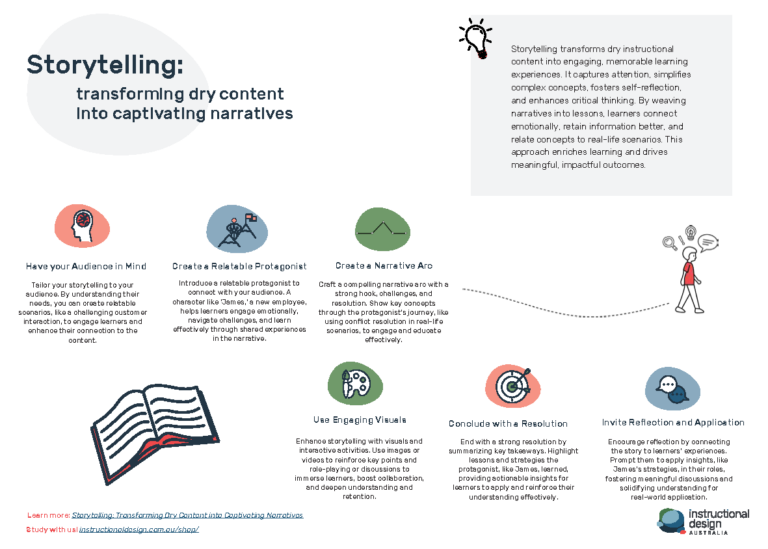Storytelling: Transforming Dry Content into Captivating Narratives
FREE download
Complete the form to download a quick reference guide (QRG) for creating effective learning outcomes using Storytelling.

As a learning designer, you know that creating engaging content is no small feat. But what if you could transform even the most monotonous material into something vibrant and memorable?
Enter storytelling! By weaving narratives into your lessons, you can transport your audience on a journey, leaving them hanging on your every word. Let’s explore why storytelling is important for learning designers and how it can benefit your audience.
Storytelling for Learning Design
Storytelling is the art of using a narrative structure to convey information or ideas in a way that is memorable and engaging. Fables, for instance, are imaginative stories that captivate young minds while imparting important values.
While a lesson alone may feel dry, the story helps draw in these eager minds and make the knowledge more accessible and compelling. The same principles that make fables so effective can be harnessed to breathe life into your learning design courses.
Benefits of Storytelling for Dry Content
1. Catches Audience Attention
One of the primary reasons storytelling is so vital in education is its ability to engage learners. Humans are naturally drawn to stories; they evoke emotions and spark curiosity. When learners are emotionally invested in a narrative, they’re more likely to pay attention, retain information, and participate actively. By using storytelling, you create a dynamic learning environment that keeps your audience interested.
2. Simplifies Lessons
Stories help to simplify complex concepts. When information is presented within a narrative context, it becomes easier to digest and remember. Instead of trying to memorise a list of facts, learners can associate key ideas with characters and situations. This contextual learning not only aids retention but also makes the content more meaningful and applicable in real-world scenarios.
3. Allows for Self-Reflection
Storytelling allows learners to step into someone else’s shoes, fostering empathy and understanding. When they relate to a character’s struggles and triumphs, they can better appreciate different perspectives and experiences. This is particularly important in professional training, where understanding diverse viewpoints can enhance collaboration and teamwork.
4. Promotes Critical Thinking
A well-crafted story often presents challenges that require problem-solving. By following the protagonist’s journey, learners are encouraged to think critically about the choices made and the outcomes achieved. This not only develops their analytical skills but also prompts them to consider how they would handle similar situations in their own lives or work.
How to Implement Storytelling in Your Lessons
Have your Audience in Mind
Before diving into your content, think about who your learners are. Just like in fables, most stories revolve around fantastical creatures in local settings so children can easily be immersed but still have their imagination run wild. By understanding your audience, you can craft stories that resonate with them. For instance, if you’re designing a training module for customer service representatives, consider incorporating a story about a challenging customer interaction. This sets the stage for learners to relate to the scenario and feel more engaged from the get-go.
Create a Relatable Protagonist
Creating a relatable protagonist breaks the veil surrounding the audience and allows them to have a more relatable approach towards your story. Imagine introducing “James,” a new employee navigating his first week on the job. As he encounters various scenarios—like handling a difficult customer or mastering a new system—learners can follow his journey and learn alongside him.
Create a Convincing Narrative Arc
Just like any good story, your lesson should have a clear narrative arc. Start with a hook that grabs the learner’s attention – perhaps a surprising statistic or a thought-provoking question. Then, outline the challenges your protagonist faces. How does James struggle with a particular task? This conflict will keep learners engaged, as they’ll be eager to see how he overcomes these hurdles.
As you present the content, weave in the key concepts and skills that learners need to grasp. Instead of simply listing facts, show how these elements play a crucial role in the protagonist’s journey. For example, when discussing conflict resolution techniques, illustrate how James uses these skills in a real-life scenario. This not only makes the information more digestible but also reinforces its practical application.
Use Engaging Visuals
To complement your storytelling, consider incorporating visuals that enhance the narrative. This could include images, infographics, or videos that illustrate key points or character developments. Visual storytelling can be a powerful tool to solidify understanding and retention.
Additionally, think about integrating interactive activities. Maybe learners can role-play scenarios based on James’s experiences or participate in group discussions about how they would handle similar challenges. These activities encourage collaboration and create a more immersive learning environment.
Conclude with a Strong Resolution
Every story needs a resolution, and this is your opportunity to summarise the key takeaways. After James has navigated his challenges, what lessons has he learned? What strategies has he implemented that your learners can adopt? By tying everything together, you reinforce the content while ensuring that learners leave with actionable insights.
Invite Reflection and Application
Finally, wrap up your lesson by encouraging reflection. Prompt learners to consider how the story relates to their own experiences or how they might apply what they’ve learned in their roles. A simple question like, ‘How can you use James’s strategies in your work?’ can stimulate meaningful discussions and help solidify learning.
Conclusion
The true art and skill of a learning designer is how to make even the driest of lessons into something engaging and enjoyable. By focusing on your audience, creating relatable characters, and building compelling narratives, you can foster a deeper connection with your learners. Storytelling can not only give form to your lesson, but it can also turn your lessons into life-teaching anecdotes. So go ahead and embrace storytelling as a way to bring your lessons to life. After all, everyone loves a good story!
Related article: Storytelling
